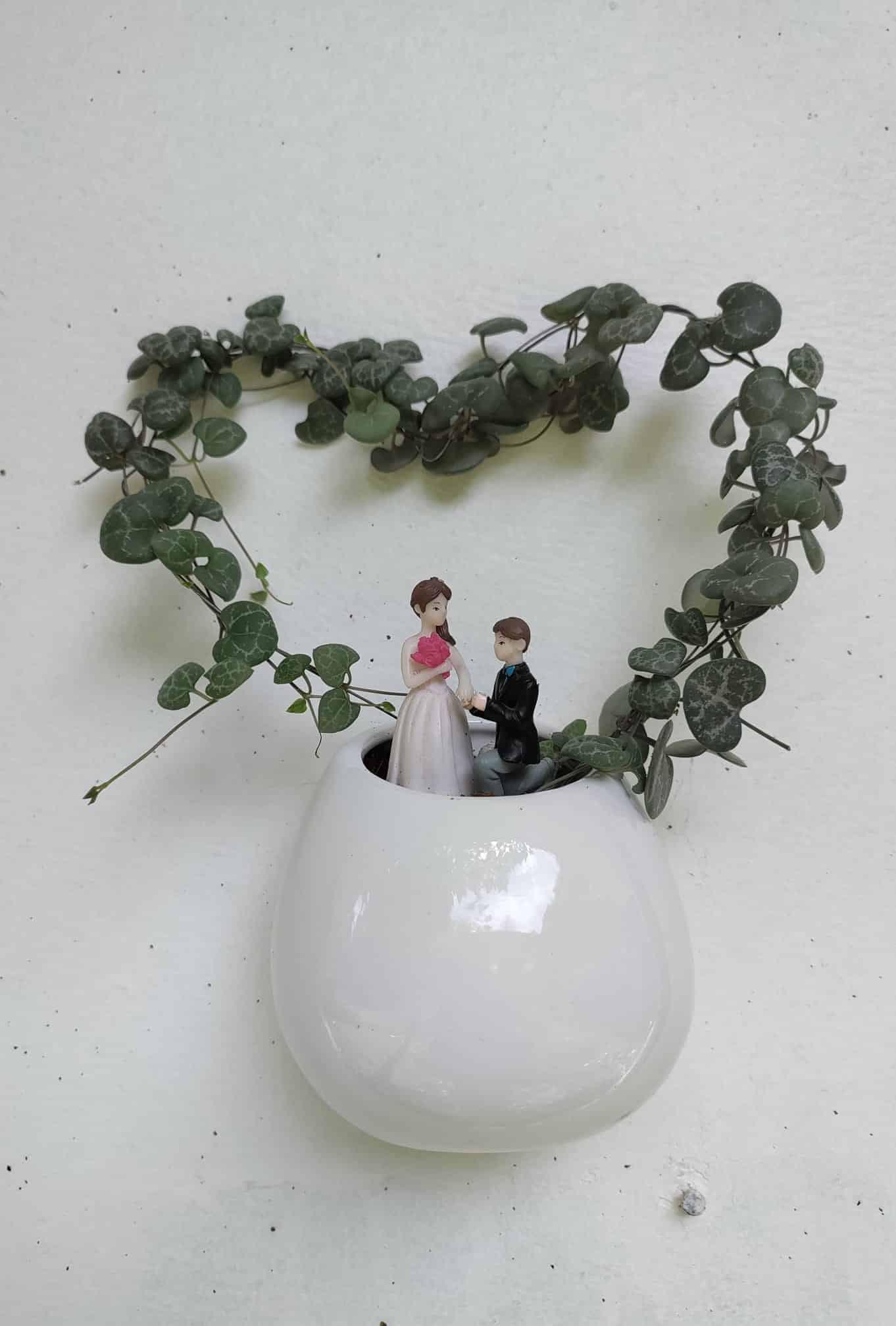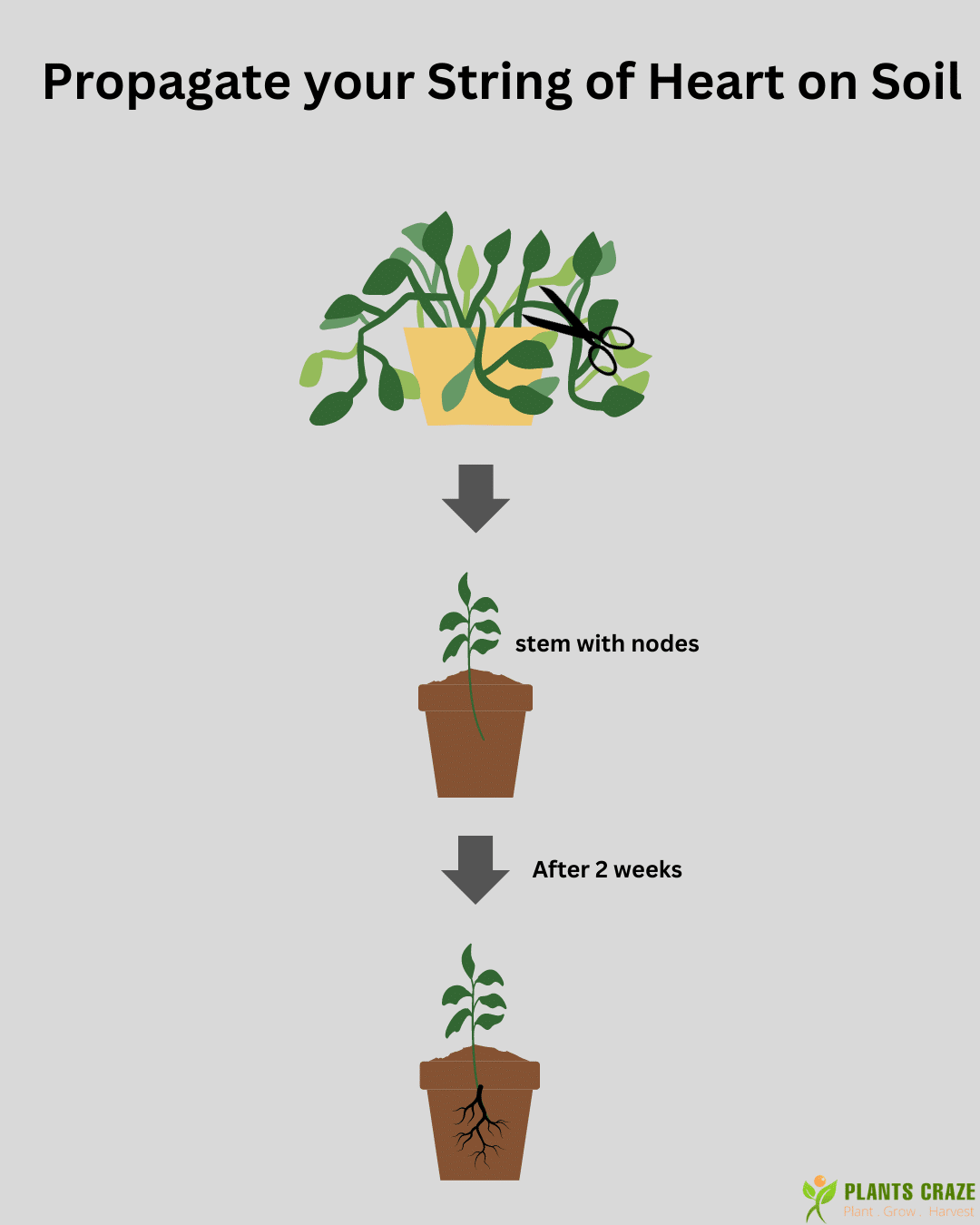The String of hearts, also known as Ceropegia woodii, is the perfect trailing succulent to hang in your living space.
So, follow this article till the end for failproof guides on propagating String of Hearts.
Table of Contents Show
Why Propagate String of Hearts?
Propagating your String of hearts is a cost-effective technique to increase the species and develop new cultivars and types with distinct traits.
Here are a few reasons to propagate your String of hearts.
- If your plant’s roots have developed into a dense, knotted mass with little or no place for new growth.
- When your String of hearts suffers from root rot, you must propagate it into a fresh medium to protect it from dying.
Best Time to Propagate String of Hearts
The best time to propagate the String of hearts is the plant’s growing season, such as spring and summer.

Cutting from an active plant during these seasons is also less likely to stress the plant.
Furthermore, springtime encourages the growth of green and flexible stems. They’re simple to cut and develop roots in a matter of weeks.
However, you should avoid propagating during the winter as your plant is more vulnerable and have less chance of succession.
Material Required for Propagation
To successfully propagate Your String of Heart, propagating tools are the primary things to take care of.
Use the materials from this list to get genetically strong, disease-free varieties of String of Heart.
| Items | Purpose |
|---|---|
| Pruning Shears | For trimming and pruning tasks of the plant |
| 98% Isopropyl Alcohol | To sterilize pruning scissors or shear |
| Potting Mix | A coarse soil such as cactus mix or peat moss potting mix works well |
| Clean, tepid water | For propagation via water |
| 3-4 inch clay, terracotta, or plastic pot | Ensure the container has multiple drainage holes |
| 500 ml transparent glass vase | For propagation via water |
| Newspaper | To collect scraps, debris and to protect the surface |
String of Hearts: Propagation Methods
Although some approaches might take significantly longer, stem cuttings, root division, or seed germination are all feasible options for reproducing them.
1. Propagation via Stem Cutting
Regarding stem cutting, you can propagate your String of hearts in soil or water medium.
Taking the Cutting
Properly cutting the stem is a crucial propagation step, as the entire process depends on it.
- Take the two-inch plant section with at least two healthy leaves at the top and a few nodes (bumps on the stem).
- Cut the stems with an exposed node that is slightly protruding. Snip right below the node to leave as little stem as possible.
- The more nodes you have, the better your chances of success.
- Remove all of the lower leaves except two at the top.
- Snip the plant’s leggy sections and use them for propagation instead.
Rooting the Cutting in Water
Water propagation is the easiest method if you are a beginner.
With this propagation method, your String of hearts will develop new roots.
Here is the water propagation step-by-step guide.
- Immerse your vine cutting in rain or distilled water in a vase or glass container.
- Be sure not to immerse the leaves in the water to avoid bacterial infections.
- Then, position your String of hearts in a well-lit, warm environment with plenty of indirect sunlight.
- Change the water every two weeks or when it becomes discolored.
You’ll notice the plant’s roots sprout in one or two weeks.
Transporting your propagated plant into the pot is essential once the roots are at least 1/2″ long.
As water propagation occurs in a transparent container or glass, you can track the growth of the roots of your cutting.
However, water propagation is quite a long process requiring more attention and effort.
Rooting the Cutting in Soil
Compared to water propagation, soil propagation is a more direct and easy variation.
You can immediately forget the water process and move the cutting to the soil.

Here’s a step-by-step instruction for soil propagation.
- Coat the ends of your plant’s cutting with rooting hormone powder to promote root development.
- Then, prepare the well-draining succulent or cactus mix and hydrate the soil until moist.
- It would be best if you buried the leafless nodes in the soil. However, be sure not to plant it too deep in the soil.
- Cover your plant with filtered sunlight with a transparent bag to maintain humidity.
- Mist your potted cutting every day to stimulate rooting.
In soil propagation, rooting might take two weeks to two months.
Unlike water propagation, it’ll be difficult to track the progress of the cutting.
However, your plant is good to go if there is a healthy stem.
Similarly, you can gently pull on the cutting and note the plant’s resistance to know whether your cutting is rooted.
For faster rooting, try laying your potted plant on a heat mat.
2. Propagation by Root Division
The String of hearts propagation by root division is a simple process and typically the effective and quickest method to generate new species.
You can use this approach in various ways: divide the root ball, utilize the aerial tubers or split individual bulbs in the soil.
The most basic strategy for developing a more extensive, healthy String of hearts is to separate the root ball into portions containing many tubers.
Here’s a step-by-step instruction for root division propagation.
- Pick a new container and fill its bottom with a coating of well-draining soil mix.
- After carefully packing soil, untangle the root vines and break them into significant parts.
- Place each new division in a pot at the same depth as in the original container.
Plants may face fewer threats of diseases and pests, but there may be prolonged growth when replicating through root division.
3. Propagation by Tuber
If you observe your String of hearts, you’ll be able to notice aerial tubers which grow along the strands of your old plant.
These tubers resemble marbles and may be placed in soil to generate new vines.

Here is a step-by-step guide to propagating a String of hearts through tuber.
- Remove the biggest tuber from your plant, leaving a small portion of the original vine intact.
- Bury the tuber gently down the potting soil timber entirely in the soil. It would be best to bury it until submerged in the soil.
- After burying the tuber, regularly moisten the soil, and after a few weeks, you’ll notice the generation of roots and new vines.
Tuber propagation is an excellent approach to utilizing an older String of Heart plant to generate a new plant.
Note: You can find tubers only on an older plant, making this method inaccessible to the gardeners with a younger String of hearts.
4. Propagation by Seeds
One of the most interesting aspects of the String of hearts is that this plant blooms.
You’ll notice strange blooms resembling flamingo heads and can yield seeds that can be used to start new plants.
Your seed pods will emerge if pollinated. You can see lengthy and woody seed pods with splits in both directions.
It would be best to allow the seed pod to crack independently and the seeds to fall out before proceeding.
Once the seed pod opens up, you’ll notice tiny seed parachutes similar to dandelion seeds.
You can easily get seeds from local or online stores if you don’t have a mother plant to collect seeds.
You can grow your String of hearts from seed by following the steps.
- Prepare a seedling tray, preferably with a humidity dome, to constrain the moisture.
- Sow the seeds with tweezers, insert 1-2 seeds per container filled with succulent soil mix, and lightly cover the seeds with soil.
- Sprinkle the soil using a spray bottle to avoid damaging the set ground of the seeds.
- Put your seedling tray in a warm position where it’ll receive bright indirect sunlight.
- It’ll take 2-3 weeks for the seeds to germinate, and once the seedling is noticeable, you can remove the humidity dome.
- Keep the soil mildly moist until the leaves have emerged, and then you can transit to a regular watering pace for the plant.
However, seed propagation might take longer and is comparatively less efficient than the other methods.
5. Propagation by Butterfly Method
Butterfly propagation is a unique method to reproduce the number of your String of hearts plant.
This method requires sphagnum peat moss, which is uncommon in all previous methods.
- Firstly, choose a vine where a couple of leaves connect and cut off on both sides, leaving about 1/4 inch.
- Fill a bowl halfway with warm water and soak sphagnum peat moss for 5 minutes.
- Squeeze out the excess moisture from the soaked moss and fill a container halfway with moss.
- On top of the sphagnum moss, arrange the leaf cuttings. Make sure to place the nodes in direct contact with the moss.
- Place the cuttings in an indirect but bright light area and cover the container with a transparent lid.
- Be sure to check the container weekly to see the resulting growth.
Due to additional nutrition, your String of hearts will turn out fuller and more significant.
However, the butterfly method is relatively long compared to other approaches.
Tips to Care for a Newly Potted String of Hearts
After propagation, you must take care of your plant’s growing condition for its healthy growth.
Here is a list of things to note after propagation so you can adequately care for your plant.
- You can keep your String of hearts at room temperature. However, 60 to 80 degrees Fahrenheit is ideal for your plant.
- Use a humidifier or pebble tray to increase the humidity and temperature of your plant.
- Keeping your plant away from cold drafts, air conditioning, and drafty windows is essential.
- When picking containers, choose a planter that will allow your String of hearts to drain, such as porous terracotta or an unglazed pot.
- Make sure to re-pot your String of hearts every 1 to 2 years in 1 inch bigger pot.
- Similarly, water your plant once a week from spring to fall.
- Feed your String of hearts once a month with a diluted standard houseplant fertilizer during the growing season for rapid growth.
FAQs About String of Hearts Propagation
Can a String of Hearts Tubers be Rooted in Water?
It is feasible to root the String of heart tubers in water for propagation.
However, it is a complex and unreliable process, as you should always keep the bulb above the waterline. If submerged, the tubers will suffer from rot.
Is it Possible to Grow a String of Hearts from a Single Leaf?
Growth from a single leaf is conceivable for a String of hearts. However, this method lacks a high success rate.
Watch the video for more care tips,
From Editorial Team
Make your Pot fuller with String of Heart!
If you want to make your String of Heart fuller but have only one or two long vines, you can simply multiply your vines.
Attach the vines to the plant base, leaving the plant nodes to touch the soil, which eventually produces new plants making your pot fuller.


